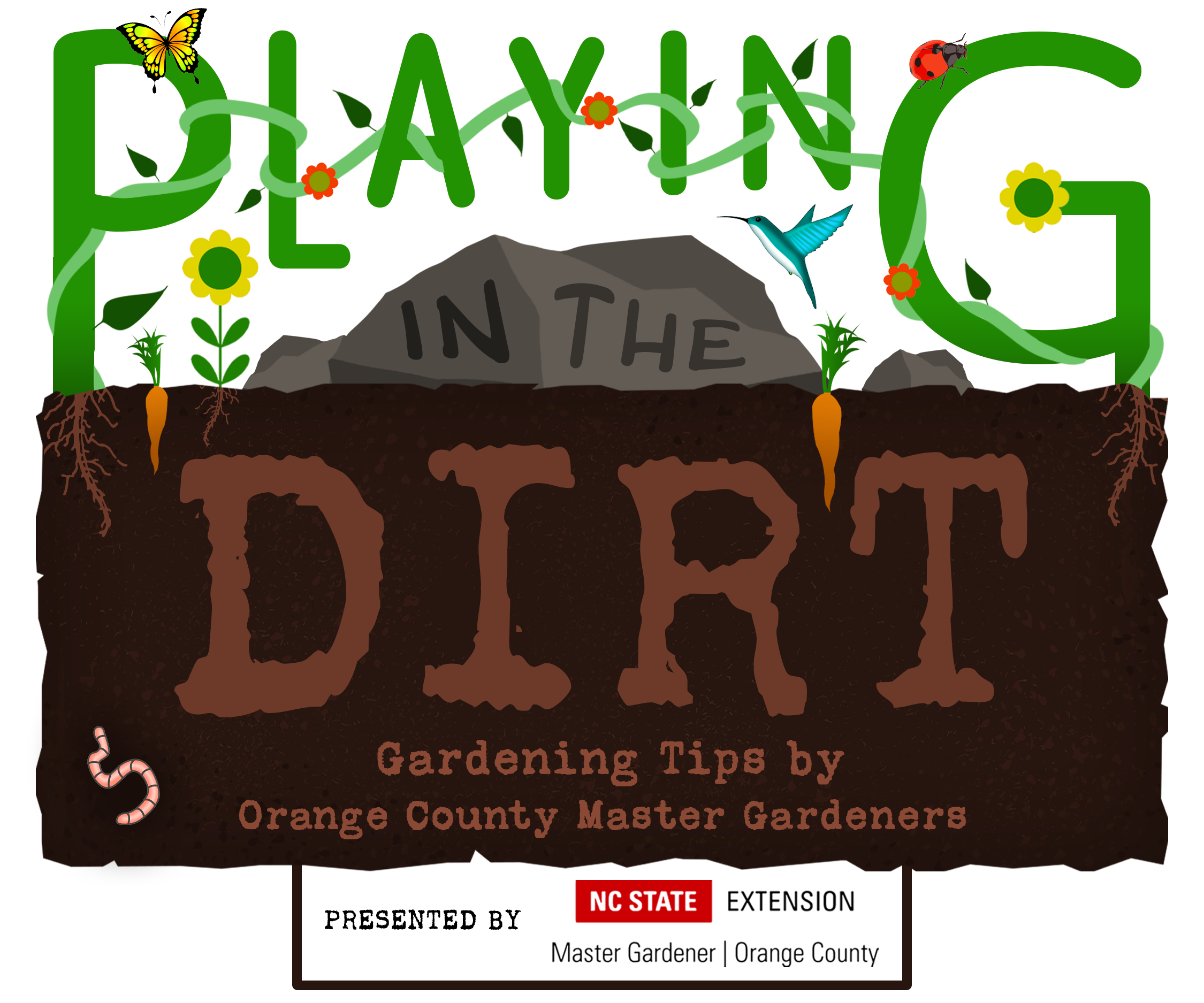
97.9 The Hill and Chapelboro.com have partnered with NC State Extension Master Gardener℠ volunteers of Orange County for “Playing in the Dirt,” a monthly column providing information and inspiration to gardeners of all skill levels! Check back on Chapelboro each month for a new subject – from our gardens to yours!
By Holly Eshelman and Jackie Podger, Orange County Master Gardener℠ volunteers
Two of the most common and useful gardening tools to own are shovels and hoes. But shop at any gardening or hardware store and you’ll find several types of each. Choose the appropriate tool for the job you want to accomplish and buy the best quality tool you can afford — it will last longer and do a better job. Shoveling and hoeing can be hard on your back, shoulders and arms; take a look at last month’s Playing in the Dirt for tips on how to garden ergonomically and prevent injuries.
The Mighty Shovel
There’s a shovel for everything! As gardeners, we all have at least one. The long handled round point shovel is arguably the most useful and all-purpose. It excels at digging in all kinds of soils, from rocky to compost, and in moving soil from place to place.

(Photo: Bob Niklewicz, UC Master Gardeners of Napa County.)
Specialized shovels for particular jobs include:
- Flat for scooping
- Square for soft dirt and edging
- Round for digging in very soft dirt
- Narrow for trenching or digging in tight spaces
- Long-handled when you need extra leverage
- Short-handled if leverage isn’t an issue, or if you’re a shorter person
- D-handled for a better grip
Be sure to choose a shovel that is comfortable for your height and strength, being careful that it is not too long or heavy for you. A rule of thumb is to choose a garden shovel with a length approximately the same as from the ground to between your elbow and chest height. Long handles offer greater leverage and are less tiring to use; short handles are often thicker and stronger. For general-purpose digging, lifting and moving, a long-handled shovel is ideal. Choice of handle style will depend on personal preference.

(parts of the shovel)
Proper Body Mechanics
Using a shovel properly is crucial. Here are some tips to keep in mind:
- Stand close to whatever you’re moving with your feet shoulder-width apart and your knees slightly bent to maintain balance and stability.
- Keep your back straight, head up and arms and elbows close to your body; lift the shovel load by straightening your knees. Your legs should carry the load, not your back or arms.
- Never twist your body while lifting or digging, as this can strain your back and cause injury. Turn your feet and body in the direction you wish to drop the shovel load.
Keeping Your Shovels in Good Shape
Soil is abrasive and rocks tend to turn a shovel blade into a blunt instrument, rather than a keen digging machine. Keeping your shovel in good condition so it can do its job well will save you work and help prevent injury. Wipe off tools after use and store them in a dry place. A rusty shovel can be revived by applying a coat of WD-40 and cleaning with steel wool or a wire brush. Mineral or linseed oil will extend the life of unfinished wood handles. Avoid leaving a wood-handled shovel out in the rain — the wood can decay inside the shovel head attachment area and result in the shovel head breaking off.
The shovel is the simplest garden tool to sharpen and doesn’t need to be very sharp. You’d like it sharp enough to slice through roots, but not so sharp that the edge chips when it meets something harder. Along with using personal protective equipment (like safety gloves and goggles), a flat mill file, also called a single-cut file, bastard-cut (referring to the coarseness), is the only tool really necessary to sharpen a shovel.
The Useful Hoe
There are as many as 48 kinds of hoes with varied appearances and purposes. Some offer multiple functions, while others have only a single specific purpose. They are used for soil cultivation, weeding garden paths, preparing seedbeds, tilling soil, creating furrows, weeding small spaces between crops and spreading mulch.
To select the right hoe, consider the function you want it to serve — usually either weeding or digging. Some weeding hoes have sharp angled blades that slice along the upper layer of soil to cut or uproot weeds. Digging hoes are used for digging and tilling with a chopping action, which keeps the soil loose. These hoes have thick flat triangle or rectangular blades attached at a 90-degree angle and are effective in tight spaces in all soils for digging out difficult weeds or creating long straight furrows.
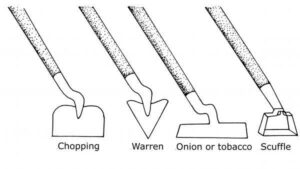
(NC Extension Gardener Handbook.)
Four main types of hoes are commonly used to perform garden tasks:
A draw hoe has a small rectangular or square head and is used by chopping into the soil in an up-and-down motion, breaking up clods and pulling the soil toward you. It can also be used for digging up weeds at the roots. The draw hoe is best for large-scale tasks.
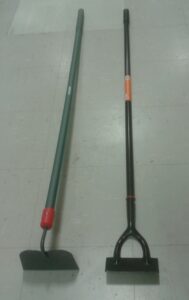
Draw hoe (left) and Dutch hoe. (Photo: Batternut, CC BY-SA 4.0.)
A Dutch hoe has a sharp, wide and open blade that skims just below the surface of the soil to sever weeds from their roots and is often the easiest to use. Used standing upright, it is designed to be pushed or pulled through the soil with a blade that’s sharp on every side so it can cut either forward or backward.
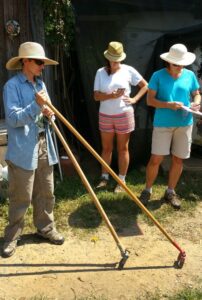
Gardeners discuss scuffle hoes. (Photo: Debbie Roos.)
A stirrup or scuffle hoe is ideal for shallow weeding in medium or soft soil, cutting smaller weeds and uprooting the rest. The narrow blade has a pivot that lets it easily skim across the top of the soil on the forward stroke, then scrape and churn through the soil at a shallow angle as you pull the hoe backward. The stirrup hoe’s head is loosely held or hinged to the handle to allow use in a back-and-forth motion in either direction.
The warren or pointed hoe is lightweight with a heart- or triangle-shaped pointed head. This hoe works well for digging small holes for individual plants such as seedlings or annuals in cell packs, creating furrows for planting vegetables, cultivating between plants or also digging out weeds with spreading roots.
Another hoe, a swoe, with its sharp pointed tip on a triple-edged wedge-shaped head can slide under weeds that form rhizomes or runners (such as Creeping Charlie) to uproot the mass. It features a push and pull action for severing weeds from their roots, is perfect for weeding around and behind plants in tight spaces and can slip into pavement cracks to pull out weeds.
Other hoes you may find in a gardening store or catalog include heart-shaped for breaking up hard or compact soil, half-moon for weeding, flat hoe for weeding in loose or soft soil and flower hoe with a very small blade.
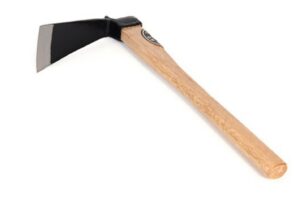
Kana hoe – similar to a swoe but on a short handle. (Photo: Master Gardeners University of California Extension.)
Short-Handled Garden Hoes
Sometimes you’re better served by a short-handled version of a particular hoe. On your knees in a crowded perennial bed, use a short-handled scuffle hoe for shearing off the roots of tiny, thick-growing weeds that are too small to pull individually. A hand-held warren hoe is the perfect tool for planting and weeding in a raised vegetable bed.
Physical Considerations
Consider your height when purchasing a garden hoe. Hold the hoe out as if in use and grip it on the end while standing upright. Reaching out too far and bending to reach the ground strains your back, shoulders, arms and neck. You want the handle to be long enough to work with a straight back. If bending forward is uncomfortable, shop for another with a longer handle.
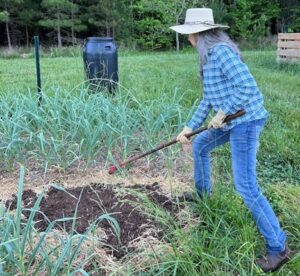
Proper weeding using a stirrup hoe, with one leg forward. (Photo: Mark Johnson.)
Maintenance
No matter what kind of garden hoe you use, you must keep it sharp for it to slice into soil and cut off weed roots properly. Carry a mill bastard file when gardening for routine filing. See the resources below for more information about sharpening tools.
Clean the hoe after each use. Apply a light coat of mineral oil or general household lubricating oil to the blade before storing for winter to keep the hoe from rusting and becoming dull. Prevent the spread of disease between plants by thoroughly cleaning and disinfecting your tools, equipment and garden implements.
Read More:
- Weeds and Garden Cultivation, Chatham County Extension.
- Choosing Garden Tools, Nebraska Extension in Lancaster County.
- How to Select Quality Landscape and Garden Tools, Kansas State University Research and Extension.
- How to Clean and Sharpen Tools, Kansas State University Research and Extension.
- Sharpening Garden Tools, Oregon State University Extension.
- Safe Use of Rakes and Shovels, Master Gardener Program, University of California Agriculture and Natural Resources.
- Horticulture Equipment Management, Master Gardener Handbook, Idaho Extension.
More from the Master Gardener volunteers of Orange County:
- Have a plant or garden question? Email the Orange County Master Gardener volunteers at ocmgardeners@gmail.com or phone 919-245-2061.
- Subscribe to The Garden Buzz, the Orange County Master Gardeners’ monthly newsletter, for gardening news and tips. And visit our website, The Orange Gardener, for helpful gardening information and tips.
- Follow us on Facebook! Our page is Orange County NC Extension Master Gardener Volunteer.
Chapelboro.com does not charge subscription fees, and you can directly support our efforts in local journalism here. Want more of what you see on Chapelboro? Let us bring free local news and community information to you by signing up for our newsletter.

